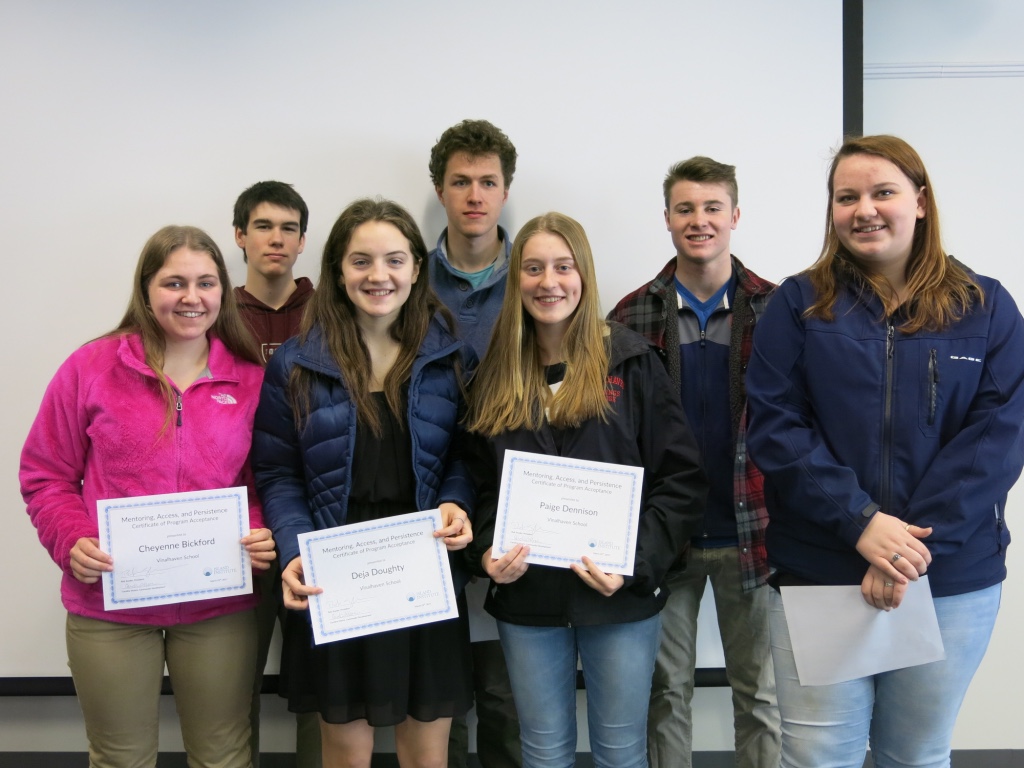The Mentoring, Access and Persistence (MAP) program for high school juniors launched in March with a lunch and learning session in Northport. 16 students will be supported as they apply to and begin post-secondary education.
We sat down with Caroline Moore, Community Development Associate, to learn more..
Tell me about the students in MAP and why this program is important for them.
MAP scholars are high school juniors from Maine’s year-round, unbridged islands who are interested in or considering pursuing some sort of post-secondary education. This year, we have MAP scholars from five different islands. Some have parents or older siblings who have been to college, while some will be the first in their family to attend college. They all have their unique interests and passions, which range from computer science to nursing, from fishing to occupational therapy, from sailing to basketball to snowshoe running…
How, and why, is this different from the support we have provided in the past?
In the past, we’ve provided scholarships to high school seniors and college students, once they’d applied to some post-secondary program. With the transition to MAP, we’re excited to start working with students earlier in the process —during their junior year of high school—and to be a resource for students above and beyond providing financial scholarship. A summer leadership intensive, monthly webinars, an online resource toolbox, and access to a peer mentor are just a few resources students will have access to. Through these supports, we hope to increase not only student access to post-secondary education, but also persistence through graduation.
Why do island students in particular need this extra support?
Can you imagine going from a graduating class of ten students to setting foot on campus at the University of Maine at Orono for the first time? Talk about a culture shock! While not all of our MAP students attend high school on their island, the transition from a small community where you are known to a much larger school and community experience is something island students have in common, and can be hard for others to fully understand. That’s why we’re excited to pair MAP students with peer mentors who have been through that transition as one way to support students through this transition. Additionally, it can be hard to convince some college representatives to take a ferry to meet with only a handful of students. By providing information through webinars and virtually inviting speakers, we look to connect MAP students with resources that may be more readily accessible to other students.

What are other programs you’re working with or are modeling this after?
SO MANY. In addition to background research on programs in Maine and across the country, we’ve been focusing on building a number of local and statewide partnerships to inform our programming and better support students. I’ve been blown away by the willingness of others to collaborate and share resources; this is an exciting time to be engaged in this work. Project Launch, the Maine Seacoast Mission, the Mitchell Institute, Aroostook Aspirations Initiative, the Worthington Scholars, and Upward Bound are just a few of the local programs that we’ve been collaborating with.
What has been the most fun, and the most challenging about setting this up?
Delving into the research and curriculum-building portion of MAP has probably been both the most fun for me. My background is in Biology and Education, and I have really enjoyed the opportunity to put my “teaching hat” back on and consider the best ways to meet MAP students where they are in the process of exploring post-secondary options and support them through that discovery. The challenge is that high school students are so busy! Between school, boat schedules, athletics, extra-curriculars, and jobs, finding a time to meet together as a cohort can be difficult. That’s why we’re excited to offer an in-person leadership training over the summer and why will be recording and posting our webinars so that if students can’t attend the webinar, they still have access to that information.
What is exciting about this to you personally?
I studied Education in college, and did my student teaching at the high school level. I taught at Greely High School, and actually had a few students from Chebeague in my classes! With MAP, I’m really excited to re-connect with that high school age group on a deeper level – to get to know and support them as best as I can.
Are the island schools really different from one another?
Yes, island education looks different on all the islands! Of the fifteen year-round, unbridged islands, there are three islands with K-12 schools, seven with K-8 schools, and four with K-5 schools. Not only does enrollment differ between island schools, but the necessity to go off-island for education does as well. For students with K-5 or K-8 schools on island, that means commuting or boarding off-island to get to school beginning as early as the sixth grade. And for students who live on islands that don’t have round trip ferries every day, that could mean attending a boarding school, boarding with someone on the mainland, or even whole families moving off island during the middle and/or high school years.
What else should people know about MAP?
MAP is certainly a community collaboration. From the numerous organizations who have helped to inform the program, to community members who encouraged juniors to apply, to individuals who have stepped up to offer their expertise to read essays and present at webinars and other times, we are incredibly grateful for everyone’s willingness and enthusiasm to come together to best support students. If you have a resource that we should know about or a skill set to offer, please reach out!


